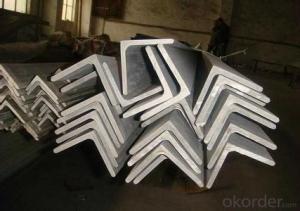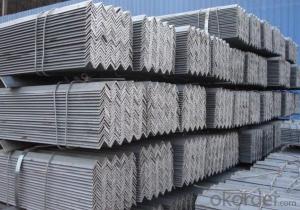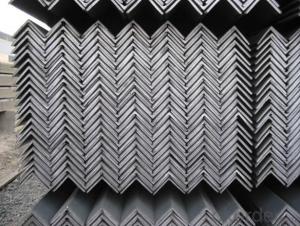Angle steel GB Q235B high quality 20-250MM
- Loading Port:
- Shanghai
- Payment Terms:
- TT OR LC
- Min Order Qty:
- 25 m.t.
- Supply Capability:
- 20000 m.t./month
OKorder Service Pledge
OKorder Financial Service
You Might Also Like
Angle Steel Details:
| Minimum Order Quantity: | 25mtons | Unit: | m.t. | Loading Port: | China Main Port |
| Supply Ability: | 80000-100000MTS/YEAR | Payment Terms: | TT or LC |
Product Description:
Specifications of Angle Steel
1. Invoicing on theoretical weight or actual weight as customer request
2. Length: 6m, 9m, 12m as following table
3. Sizes
Sizes: 25mm-250mm | ||
a*t | ||
25*2.5-4.0 | 70*6.0-9.0 | 130*9.0-15 |
30*2.5-6.6 | 75*6.0-9.0 | 140*10-14 |
36*3.0-5.0 | 80*5.0-10 | 150*10-20 |
38*2.3-6.0 | 90*7.0-10 | 160*10-16 |
40*3.0-5.0 | 100*6.0-12 | 175*12-15 |
45*4.0-6.0 | 110*8.0-10 | 180*12-18 |
50*4.0-6.0 | 120*6.0-15 | 200*14-25 |
60*4.0-8.0 | 125*8.0-14 | 250*25 |
5. Payment terms:
1).100% irrevocable L/C at sight.
2).30% T/T prepaid and the balance against the copy of B/L.
3).30% T/T prepaid and the balance against L/C
6.Material details:
Alloy No | Grade | Element (%) | |||||
C | Mn | S | P | Si | |||
|
|
|
|
|
|
| |
Q235 | B | 0.12—0.20 | 0.3—0.7 | ≤0.045 | ≤0.045 | ≤0.3 | |
|
|
|
|
|
|
| |
Alloy No | Grade | Yielding strength point( Mpa) | |||||
Thickness (mm) | |||||||
≤16 | >16--40 | >40--60 | >60--100 | ||||
≥ | |||||||
|
|
|
|
|
| ||
Q235 | B | 235 | 225 | 215 | 205 | ||
Alloy No | Grade | Tensile strength (Mpa) | Elongation after fracture (%) | ||||
Thickness (mm) | |||||||
| ≤16 | >16--40 | >40--60 | >60--100 | |||
≥ | |||||||
|
|
|
|
|
|
| |
Q235 | B | 375--500 | 26 | 25 | 24 | 23 | |
Usage & Applications of Angle Steel
According to the needs of different structures, Angle can compose to different force support component, and also can be the connections between components. It is widely used in various building structures and engineering structures such as roof beams, bridges, transmission towers, hoisting machinery and transport machinery, ships, industrial furnaces, reaction tower, container frame and warehouse etc.
Packaging & Delivery of Angle Steel
1. Packing: it is nude packed in bundles by steel wire rod
2. Bundle weight: not more than 3.5MT for bulk vessel; less than 3 MT for container load
3. Marks:
Color marking: There will be color marking on both end of the bundle for the cargo delivered by bulk vessel. That makes it easily to distinguish at the destination port.
Tag mark: there will be tag mark tied up on the bundles. The information usually including supplier logo and name, product name, made in China, shipping marks and other information request by the customer.
If loading by container the marking is not needed, but we will prepare it as customer request.
Production flow of Angle Steel
Material prepare (billet) —heat up—rough rolling—precision rolling—cooling—packing—storage and transportation
- Q: Can steel angles be used for support structures in stadiums or arenas?
- Yes, steel angles can be used for support structures in stadiums or arenas. Steel angles are commonly used in construction and engineering projects due to their strength, durability, and versatility. They are often utilized in structural applications where load-bearing support is required, making them suitable for supporting the weight of stadium or arena structures. Steel angles can be used as beams, columns, or trusses to provide the necessary support and stability for large structures. Their ability to withstand heavy loads and resist bending or warping makes them a popular choice for constructing stadium roofs, grandstands, and other support systems. Additionally, steel angles can be easily fabricated and customized to meet specific design requirements, allowing for efficient and cost-effective construction of stadium and arena support structures.
- Q: What are the different surface treatments available for galvanized steel angles?
- Some of the different surface treatments available for galvanized steel angles include powder coating, painting, and hot-dip galvanizing. Additionally, there are options for epoxy coating and zinc-rich primers to enhance corrosion resistance and provide a desired aesthetic finish.
- Q: Are steel angles suitable for high-temperature environments?
- Steel angles can be suitable for high-temperature environments depending on the specific type of steel used. Certain grades of stainless steel, such as 304 and 316, are known for their excellent heat resistance properties. These stainless steel angles can withstand high temperatures without significant loss of strength or corrosion resistance. They also exhibit good oxidation resistance, which is crucial in high-temperature environments where oxidation can occur. However, it is important to note that not all steel angles are suitable for high-temperature applications. Carbon steels, for example, are not recommended for prolonged exposure to high temperatures as they can undergo significant structural changes, such as softening or even melting, which can compromise their integrity and strength. When selecting steel angles for high-temperature environments, it is essential to consider the specific temperature range, duration of exposure, and any additional factors such as corrosive gases or chemicals present. Consulting with a material engineer or a steel supplier with expertise in high-temperature applications can help ensure the selection of the appropriate steel angle with the necessary heat resistance properties for the specific environment.
- Q: Is there a screw that can be made like angle iron, but not a right angle, just a single piece of material? That's the way to break the angle iron in two. What if it's called? Thank you, professionals!
- Drilling tail screw quality is poor, hardness is not good
- Q: How much is the weight of 40 * 3 angle steel theory?
- The angle iron can be made up of different force components according to the different structure, and can also be used as the connecting piece between the components. Widely used in a variety of architectural and engineering structures, such as beams, bridges, towers, hoisting and conveying machinery, ships, industrial furnace, reaction tower, container frame and warehouse.
- Q: What is the minimum thickness for a steel angle bracket?
- The minimum thickness of a steel angle bracket depends on its specific application and the load it is meant to bear. Typically, a thickness of 1/8 inch (3.175 mm) is commonly employed for angle brackets, providing ample strength and rigidity to withstand normal loads and forces. However, it is crucial to bear in mind that for heavier loads or specialized uses, thicker steel brackets may be necessary to guarantee structural integrity and safety. It is advisable to seek the advice of a structural engineer or adhere to industry standards and guidelines to ascertain the suitable minimum thickness for a steel angle bracket in a particular application.
- Q: How do you calculate the compression capacity of a steel angle?
- To calculate the compression capacity of a steel angle, you need to consider the cross-sectional area of the angle and the material's yield strength. The compression capacity can be determined by multiplying the cross-sectional area of the angle by the yield strength of the steel.
- Q: How do you clean and maintain steel angles?
- To ensure the cleanliness and maintenance of steel angles, a few essential materials and some simple steps are required. The following guide will assist you in carrying out the process: 1. Collect the necessary materials: You will require a soft cloth or sponge, mild detergent or soap, warm water, a bucket, and a microfiber cloth or towel for drying. 2. Begin by preparing a cleaning solution: Combine a small amount of mild detergent or soap with warm water in a bucket. Harsh chemicals or abrasive cleaners should be avoided, as they can harm the steel surface. 3. Immerse the soft cloth or sponge into the cleaning solution and squeeze out any excess liquid. It is important for the cloth to be damp, not saturated. 4. Delicately wipe the steel angles with the damp cloth or sponge. Ensure that you cover the entire surface, including the crevices and corners. In the case of stubborn stains or dirt, apply slightly more pressure, but avoid scrubbing too vigorously to prevent scratches. 5. Rinse the cloth or sponge with clean water and eliminate any soap residue from the steel angles. 6. Once the cleaning process is complete, use a microfiber cloth or towel to thoroughly dry the steel angles. This step is crucial to prevent the formation of water spots or rust. 7. For regular maintenance, a stainless steel cleaner or polish can be utilized. Apply a small amount of the cleaner onto a clean cloth and gently rub it onto the steel angles, following the instructions provided by the manufacturer. This will aid in restoring shine and safeguarding the steel surface. 8. Refrain from using abrasive materials such as steel wool or scouring pads, as they can cause scratches on the steel angles. Moreover, keep acidic substances or chemicals away from the steel, as they can induce corrosion. 9. It is also advisable to periodically inspect the steel angles for any indications of rust or damage. If any rust spots are noticed, a rust remover or stainless steel cleaner specifically designed for rust removal can be used. Carefully follow the instructions provided by the product and ensure that the angles are thoroughly dried afterwards. By adhering to these steps, you can effectively clean and maintain steel angles, ensuring their excellent condition for years to come.
- Q: Can steel angles be used in fencing?
- Indeed, fencing can make use of steel angles. Steel angles find frequent application in fencing scenarios, serving to furnish structural reinforcement and stability. Their utility ranges from functioning as posts to serving as crossbars, contingent upon the particular design of the fencing. Steel angles possess robustness and durability, rendering them well-suited for enduring various elements whilst guaranteeing security. Through facile welding or bolting, steel angles can effortlessly be conjoined to construct a resilient fencing structure. Furthermore, steel angles can be galvanized or coated, augmenting their resistance to rust and corrosion, thereby securing a fencing solution that endures for a prolonged period with minimal maintenance.
- Q: What is the weight of a steel angle?
- The weight of a steel angle can vary depending on its dimensions and composition.
Send your message to us
Angle steel GB Q235B high quality 20-250MM
- Loading Port:
- Shanghai
- Payment Terms:
- TT OR LC
- Min Order Qty:
- 25 m.t.
- Supply Capability:
- 20000 m.t./month
OKorder Service Pledge
OKorder Financial Service
Similar products
Hot products
Hot Searches
Related keywords
























